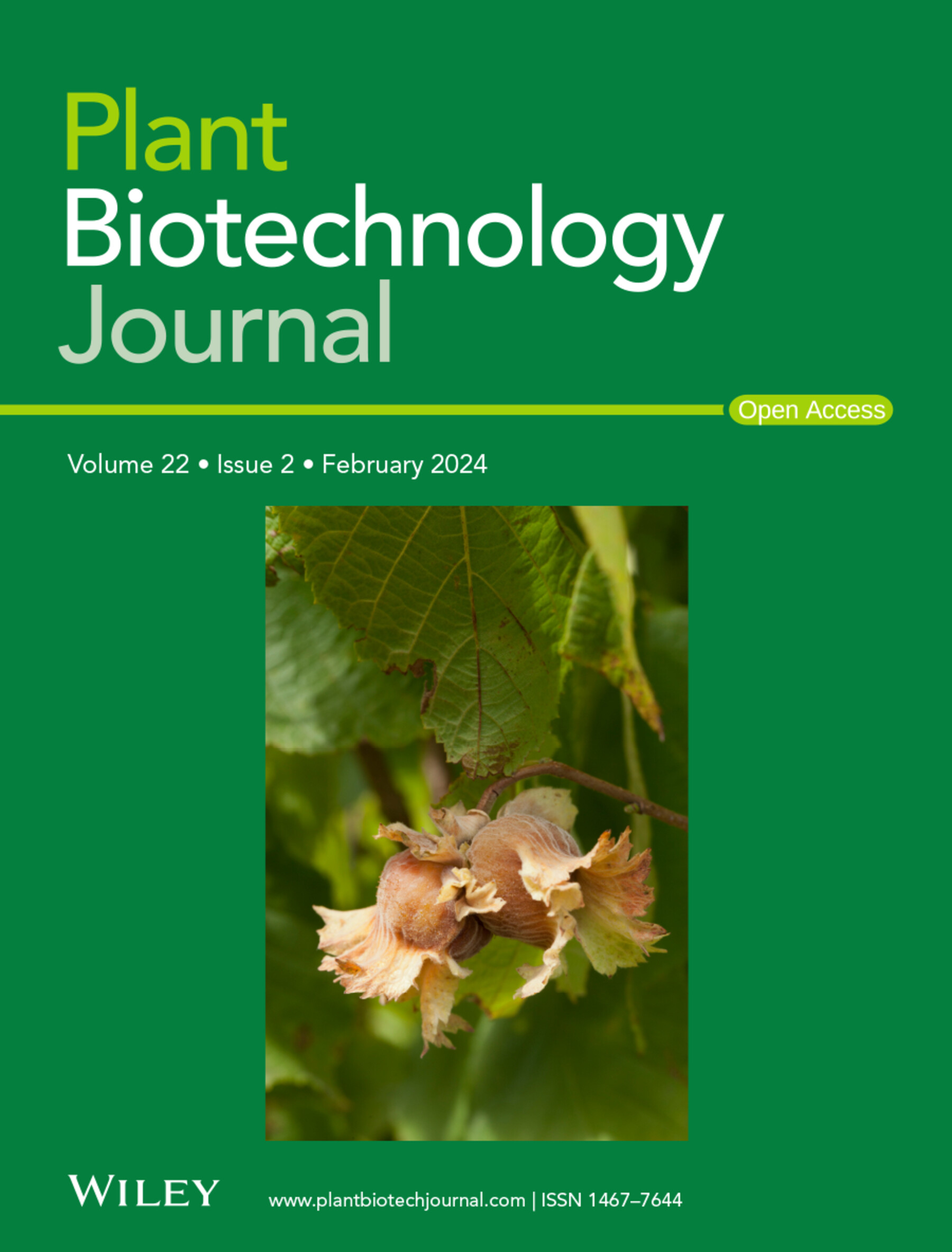编码镁螯合酶I亚基的基因缺失导致了一个新的小麦叶片颜色突变体
IF 10.1
1区 生物学
Q1 BIOTECHNOLOGY & APPLIED MICROBIOLOGY
引用次数: 0
摘要
摘要叶片颜色突变体是研究叶绿素合成、叶绿体发育和光合作用机制的理想种质资源。在这项研究中,我们获得了一个黄叶突变体,命名为SN288‐2。该突变体呈现黄叶表型,在幼苗期叶绿体发育停止,Chl积累减少。在小麦恢复期,黄叶表型恢复到正常表型。此外,黄叶中关键Chl前体原卟啉IX (Proto IX)和Mg‐原卟啉IX (Mg‐Proto IX)的比例较高。大量分离分析测序(BSA‐Seq)显示,该异常表型由位于染色体7A和7D上的两个隐性基因控制,分别命名为Y1‐7A和Y2‐7D。随后的研究集中在Y1‐7A上。我们确定TraesCS7A03G1163900是Y1‐7A的可行候选基因,该基因编码对Chl合成至关重要的Mg螯合酶的一个主要亚基。全基因组重测序和Sanger测序显示,SN388‐2的7A染色体长臂上有5.3 kb的缺失,包括整个Y1‐7A序列。实时荧光定量PCR (qRT-PCR)结果显示,Y1‐7A基因主要在绿色组织中表达,编码蛋白定位于叶绿体内。此外,加权基因共表达网络分析(WGCNA)揭示了一个与叶片发育和Chl含量恢复相关的基因模块。因此,这些结果为Chl合成和叶绿体发育的调控提供了一种新的理论。总的来说,Y1‐7A的缺失损害了Mg‐螯合酶的功能,阻断了Proto IX向Mg‐Proto IX的转化。本文章由计算机程序翻译,如有差异,请以英文原文为准。
Deletion of the gene encoding the magnesium chelatase I subunit resulted in a novel wheat leaf colour mutant
SummaryLeaf colour mutants are ideal germplasm resources for investigating the mechanisms of chlorophyll (Chl) synthesis, chloroplast development and photosynthesis. In this study, we obtained a yellow‐leaf mutant, designated SN288‐2. The variant presented a yellow‐leaf phenotype and halted the development of chloroplasts at the seedling stage, with reduced accumulation of Chl. The yellow‐leaf phenotype reverted to the normal phenotype in the wheat revival stage. In addition, the ratio of the crucial Chl precursors protoporphyrin IX (Proto IX) and Mg‐protoporphyrin IX (Mg‐Proto IX) was relatively high in yellow leaves. Bulked segregant analysis sequencing (BSA‐Seq) revealed that the aberrant phenotype was controlled by two recessive genes located on chromosomes 7A and 7D, designated Y1‐7A and Y2‐7D , respectively. Subsequent research focused on Y1‐7A . We identified TraesCS7A03G1163900 as a viable candidate for Y1‐7A , encoding a major subunit of Mg‐chelatase that is essential for Chl synthesis. Whole‐genome resequencing and Sanger sequencing revealed a 5.3 kb deletion on the long arm of chromosome 7A in SN388‐2 that encompasses the entire Y1‐7A sequence. Quantitative real‐time PCR (qRT–PCR) revealed that the Y1‐7A gene was predominantly expressed in green tissues and that the encoded protein was localized within the chloroplast. Moreover, weighted gene coexpression network analysis (WGCNA) revealed a gene module associated with leaf development and Chl content restoration. Consequently, these results provide a new theory regarding the regulation of Chl synthesis and chloroplast development. Overall, the loss of Y1‐7A impaired the function of Mg‐chelatase and blocked the conversion of Proto IX to Mg‐Proto IX.
求助全文
通过发布文献求助,成功后即可免费获取论文全文。
去求助
来源期刊

Plant Biotechnology Journal
生物-生物工程与应用微生物
CiteScore
20.50
自引率
2.90%
发文量
201
审稿时长
1 months
期刊介绍:
Plant Biotechnology Journal aspires to publish original research and insightful reviews of high impact, authored by prominent researchers in applied plant science. The journal places a special emphasis on molecular plant sciences and their practical applications through plant biotechnology. Our goal is to establish a platform for showcasing significant advances in the field, encompassing curiosity-driven studies with potential applications, strategic research in plant biotechnology, scientific analysis of crucial issues for the beneficial utilization of plant sciences, and assessments of the performance of plant biotechnology products in practical applications.
 求助内容:
求助内容: 应助结果提醒方式:
应助结果提醒方式:


